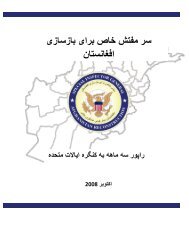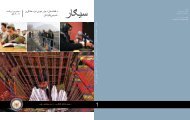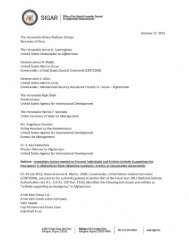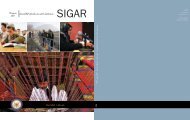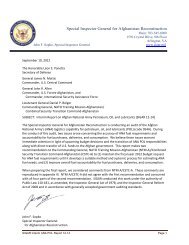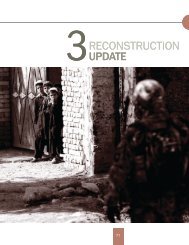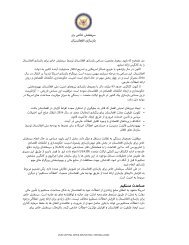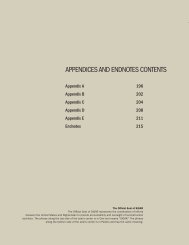Afghanistan's Control and Audit Office Requires Operational and ...
Afghanistan's Control and Audit Office Requires Operational and ...
Afghanistan's Control and Audit Office Requires Operational and ...
You also want an ePaper? Increase the reach of your titles
YUMPU automatically turns print PDFs into web optimized ePapers that Google loves.
APPENDIX I: SCOPE AND METHODOLOGYTo assess the capabilities <strong>and</strong> performance of the CAO in fulfilling its m<strong>and</strong>ate, we reviewed relevantU.S., Afghan, <strong>and</strong> international laws, conventions, st<strong>and</strong>ards, <strong>and</strong> development strategies, as well asrelevant reports, guidance, <strong>and</strong> st<strong>and</strong>ards issued by U.S. government agencies, internationalorganizations, <strong>and</strong> the CAO. We interviewed CAO leadership, advisors <strong>and</strong> department heads, as wellas officials at the Afghan Ministry of Education <strong>and</strong> Afghan Attorney General’s <strong>Office</strong>.To identify assistance provided by the United States <strong>and</strong> other donors to strengthen the CAO’sinstitutional development, we interviewed <strong>and</strong> received documentation from officials at U.S.government agencies <strong>and</strong> international organizations, including USAID; the Government Accountability<strong>Office</strong>; the World Bank; UNODC; the European Police Mission to Afghanistan; the United NationsDevelopment Program; the Embassy of the United Kingdom in Afghanistan; INTOSAI; <strong>and</strong> the AsianOrganization of Supreme <strong>Audit</strong> Institutions.To assess the effectiveness of U.S. assistance to the CAO, we used information obtained through thedocuments <strong>and</strong> interviews described above <strong>and</strong> developed conclusions based on that evidence. Afteridentifying gaps in the CAO legislative framework <strong>and</strong> operational shortcomings, we compared thosefindings with the provision of U.S. assistance to determine whether that assistance might effectivelyassist the CAO in filling those gaps <strong>and</strong> overcoming the shortcomings.This report is part of a series of SIGAR audits addressing U.S. efforts to combat corruption <strong>and</strong>strengthen the rule of law. We conducted work in Kabul, Afghanistan <strong>and</strong> Washington, D.C. fromDecember 2009 to April 2010 in accordance with generally accepted government auditing st<strong>and</strong>ards.These st<strong>and</strong>ards require that we plan <strong>and</strong> perform the audit to obtain sufficient, appropriate evidenceto provide a reasonable basis for our findings <strong>and</strong> conclusions based on our audit objectives. We believethe evidence obtained provides a reasonable basis for our findings <strong>and</strong> conclusions based on our auditobjectives. The audit was conducted by the <strong>Office</strong> of the Special Inspector General for AfghanistanReconstruction under the authority of Public Law No. 110-181, <strong>and</strong> the Inspector General Act of 1978, asamended.SIGAR <strong>Audit</strong>-10-8 Anti-Corruption/<strong>Control</strong> <strong>and</strong> <strong>Audit</strong> <strong>Office</strong> Page 20






